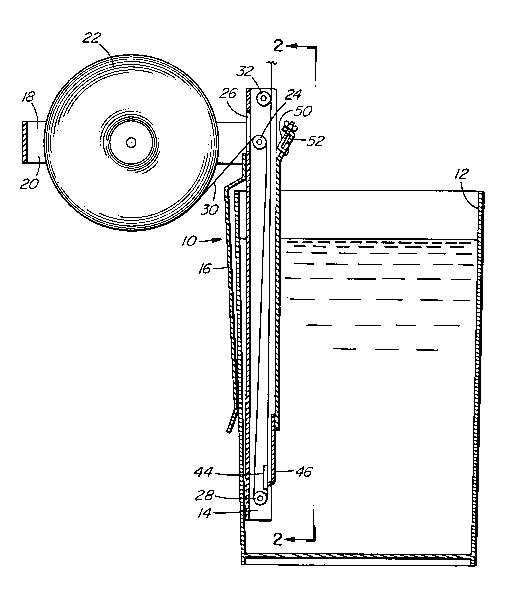Some of the information on this Web page has been provided by external sources. The Government of Canada is not responsible for the accuracy, reliability or currency of the information supplied by external sources. Users wishing to rely upon this information should consult directly with the source of the information. Content provided by external sources is not subject to official languages, privacy and accessibility requirements.
Any discrepancies in the text and image of the Claims and Abstract are due to differing posting times. Text of the Claims and Abstract are posted:
| (12) Patent: | (11) CA 2013439 |
|---|---|
| (54) English Title: | CONTAINER ATTACHMENT DEVICE FOR APPLYING PLASTER OR CEMENT TO A TAPE |
| (54) French Title: | DISPOSITIF DE FIXATION DE CONTENANT POUR APPLICATION DE PLATRE OU DE CIMENT SUR UN RUBAN |
| Status: | Term Expired - Post Grant Beyond Limit |
| (51) International Patent Classification (IPC): |
|
|---|---|
| (72) Inventors : |
|
| (73) Owners : |
|
| (71) Applicants : |
|
| (74) Agent: | BORDEN LADNER GERVAIS LLP |
| (74) Associate agent: | |
| (45) Issued: | 1996-10-08 |
| (22) Filed Date: | 1990-03-29 |
| (41) Open to Public Inspection: | 1991-09-29 |
| Examination requested: | 1991-06-20 |
| Availability of licence: | N/A |
| Dedicated to the Public: | N/A |
| (25) Language of filing: | English |
| Patent Cooperation Treaty (PCT): | No |
|---|
| (30) Application Priority Data: | None |
|---|
A container attachment device for applying
plaster or cement to a tape passes the tape through a pail
of wet cement or plaster and has a doctor blade to control
the thickness and evenness of the wet cement on the tape.
The device comprises an elongate housing having a clip to
engage the side of a pail or the like adapted to contain
wet cement or the like, the housing extending into the
interior of the pail. An arm extends outwards from a top
portion of the housing above the clip. The arm has a
support adapted to hold a roll of tape. Rollers are
provided on the elongate body for guiding tape from the
roll down to the lower end of the elongate housing in the
pail, and upwards out of the pail, and the doctor blade
ensures that an even thickness of wet cement or the like
is applied to the tape before leaving the pail.
Note: Claims are shown in the official language in which they were submitted.
Note: Descriptions are shown in the official language in which they were submitted.

2024-08-01:As part of the Next Generation Patents (NGP) transition, the Canadian Patents Database (CPD) now contains a more detailed Event History, which replicates the Event Log of our new back-office solution.
Please note that "Inactive:" events refers to events no longer in use in our new back-office solution.
For a clearer understanding of the status of the application/patent presented on this page, the site Disclaimer , as well as the definitions for Patent , Event History , Maintenance Fee and Payment History should be consulted.
| Description | Date |
|---|---|
| Inactive: Expired (new Act pat) | 2010-03-29 |
| Inactive: IPC from MCD | 2006-03-11 |
| Inactive: IPC from MCD | 2006-03-11 |
| Grant by Issuance | 1996-10-08 |
| Application Published (Open to Public Inspection) | 1991-09-29 |
| All Requirements for Examination Determined Compliant | 1991-06-20 |
| Request for Examination Requirements Determined Compliant | 1991-06-20 |
There is no abandonment history.
| Fee Type | Anniversary Year | Due Date | Paid Date |
|---|---|---|---|
| MF (patent, 8th anniv.) - small | 1998-03-30 | 1998-03-24 | |
| MF (patent, 9th anniv.) - small | 1999-03-29 | 1999-03-22 | |
| MF (patent, 10th anniv.) - small | 2000-03-29 | 2000-03-21 | |
| MF (patent, 11th anniv.) - small | 2001-03-29 | 2001-03-06 | |
| Reversal of deemed expiry | 2003-03-31 | 2002-02-11 | |
| MF (patent, 12th anniv.) - small | 2002-03-29 | 2002-02-11 | |
| Reversal of deemed expiry | 2003-03-31 | 2003-03-28 | |
| MF (patent, 13th anniv.) - small | 2003-03-31 | 2003-03-28 | |
| 2004-03-29 | |||
| MF (patent, 14th anniv.) - small | 2004-03-29 | 2004-03-29 | |
| MF (patent, 15th anniv.) - small | 2005-03-29 | 2005-02-11 | |
| 2005-02-11 | |||
| 2005-10-17 | |||
| MF (patent, 16th anniv.) - small | 2006-03-29 | 2005-10-17 | |
| 2006-11-02 | |||
| MF (patent, 17th anniv.) - small | 2007-03-29 | 2006-11-02 | |
| MF (patent, 18th anniv.) - standard | 2008-03-31 | 2007-12-07 | |
| MF (patent, 19th anniv.) - standard | 2009-03-30 | 2008-11-13 |
Note: Records showing the ownership history in alphabetical order.
| Current Owners on Record |
|---|
| MELVIN L. OVENS |
| WAYNE D. KORPA |
| Past Owners on Record |
|---|
| None |